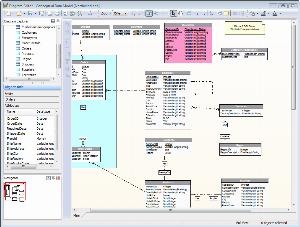Database design tools for SQL Server
List of tools that allow for the design of a database.
Database design is a set of activities aimed at improving the development, implementation, and maintenance of an enterprise data management system. Its main goal is to reflect the outline of the database system into real models: physical and logical. Database designers determine what data is to be stored inside the database, and how objects are to be related to each other.
dbForge Studio for SQL Server
dbForge Studio for SQL Server is a powerful IDE for SQL Server management, administration, development, data reporting, analysis, and a lot more. It provides database diagram tool for SQL Server where you can create new SQL Server database diagram simply dragging your database objects from Database Explorer to the diagram.
| Desktop/Cloud: | Desktop |
|---|---|
| Generate DDL scripts: |
|
| Free edition: |
|
| ER Diagram: |
|
Skipper
Skipper is a specialized tool for designing your data model and creating schema definitions.
| Desktop/Cloud: | Desktop |
|---|---|
| Generate DDL scripts: |
|
| Free edition: |
|
| ER Diagram: |
|
Apricot DB
Includes all standard facilities to design the database structures
| Desktop/Cloud: | Desktop |
|---|---|
| Generate DDL scripts: |
|
| Free edition: |
|
| ER Diagram: |
|
DrawSQL
DrawSQL helps dev teams create beautiful schema diagrams to document their database entity relationships. The app has a strong focus on crafting a delightful user experience, with keyboard shortcuts and a modern app design so you can create your document at the speed of thought. It currently supports MySQL, PostgresSQL and SQL server. It also has an extensive library of over 200+ database schemas of popular open-source packages, useful as inspiration when architecting a new app feature.
| Desktop/Cloud: | Cloud |
|---|---|
| Generate DDL scripts: |
|
| Free edition: |
|
| ER Diagram: |
|
Gleek.io
Gleek.io diagram maker is freemium text-to-diagram tool for developers and software architects. It enables the visual design of database online, in the cloud and from any browser. Create informal, UML, or entity-relationship diagrams - using just your keyboard.
| Desktop/Cloud: | Cloud |
|---|---|
| Generate DDL scripts: |
|
| Free edition: |
|
| ER Diagram: |
|
Database Workbench
Database Workbench is a complete database development tool that facilitates to design and develop from a single conceptual data model to the different DBMS specific physical models. It lets you create and modify database objects in graphical editors with no need to remember specific SQL syntax.
| Desktop/Cloud: | Desktop |
|---|---|
| Generate DDL scripts: |
|
| Free edition: |
|
| ER Diagram: |
|
GenMyModel
GenMyModel supports graphical database design based on standard E/R diagramming and documentation as well as DDL generation. with GenMyModel, data architects not only keep glossaries and data models under control, but they can design and reverse engineer data models and link them to other IT and business models, such as UML,
Archimate and BPMN.
| Desktop/Cloud: | Cloud |
|---|---|
| Generate DDL scripts: |
|
| Free edition: |
|
| ER Diagram: |
|
Qlik Data Catalyst
Qlik Data Catalyst is a metadata driven data catalog that has technical and business descriptions, data profiles, data lineage, and data tags that make data search and delivery simple. It builds a secure, enterprise-scale catalog of all the data your organization has available for analytics, no matter where it is.
| Desktop/Cloud: | - |
|---|---|
| Generate DDL scripts: | - |
| Free edition: |
|
| ER Diagram: | - |
The database design process can be very complicated. The more complex the system, the more sophisticated the tool is needed. Their functionality can vary greatly, however, core features include:
• creating and editing database objects,
• database architecture modeling,
• visualization of a database schema,
• tracking relationships between entities,
• grouping logically related objects into clusters,
• diagrams overview.
Database designer tools enable building graphical models and generating DDL scripts on their basis. The script describes data and relations between entities in the designed database. Furthermore, the tools enable reverse engineering (visualization of the model from the SQL script).
Key factors of creating a reliable and well-organized database are:
• a properly designed data structure,
• establishing what data should be stored in particular objects,
• how objects should be related to each other.
All of them can be improved by using the relevant Database design tool. Additionally, some of them allow the visual representation of data using ERD, makes it easier to visualize even more complex schemas.
Without proper software, development is based on raw code. This increases the risk of errors at the initial stage. The tools allow users to edit the visual layout using simple drag-and-drop functions. With a user-friendly interface, browsing the structure is possible even for non-IT people.
We have created a list of tools that support the process of creating database structure and its content. Our list includes free database design tools as well as advanced, more professional data management tools.
 SQL Server
SQL Server
 Oracle
Oracle
 MySQL
MySQL
 PostgreSQL
PostgreSQL
 Amazon Redshift
Amazon Redshift
 Azure SQL Database
Azure SQL Database
 DBT
DBT
 Google Big Query
Google Big Query
 IBM DB2
IBM DB2
 MariaDB
MariaDB
 SAP HANA
SAP HANA
 Snowflake
Snowflake
 SQLite
SQLite
 Teradata
Teradata
 Vertica
Vertica







